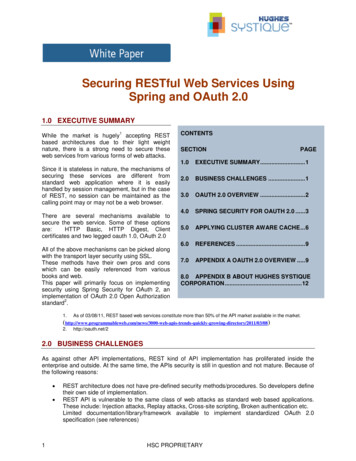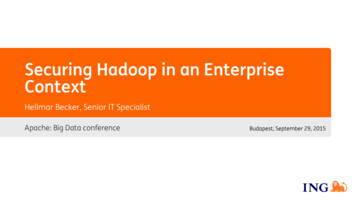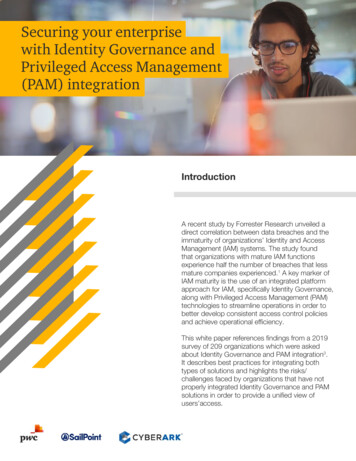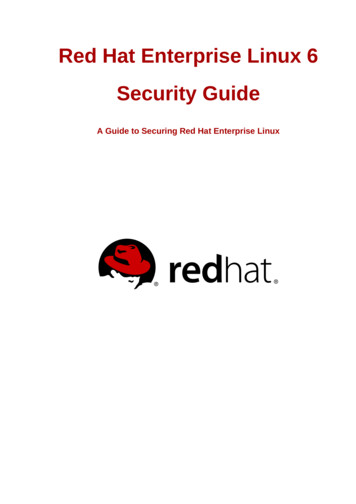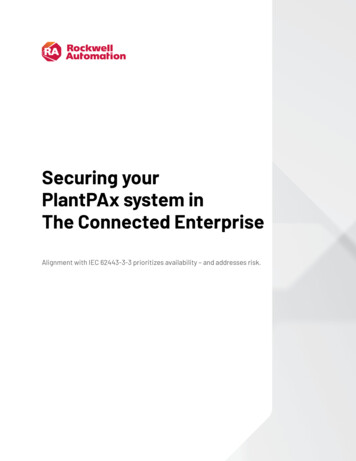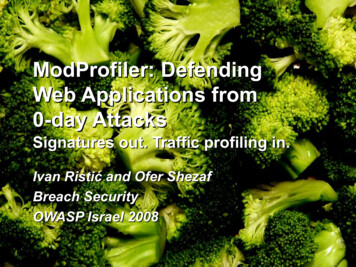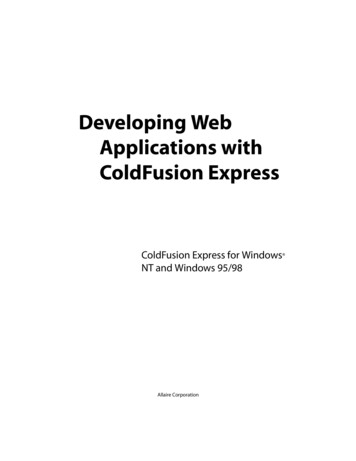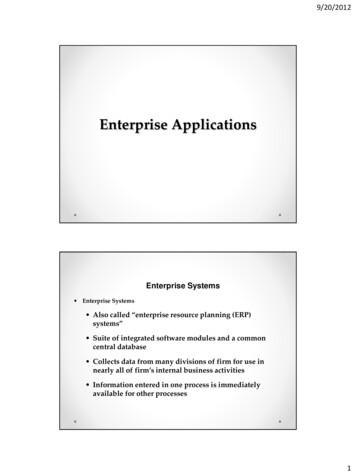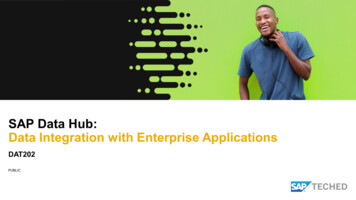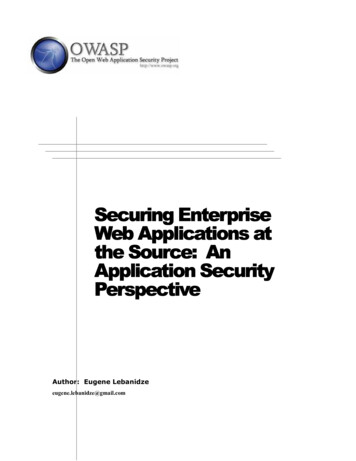
Transcription
Securing EnterpriseWeb Applications atthe Source: AnApplication SecurityPerspectiveAuthor: Eugene Lebanidzeeugene.lebanidze@gmail.com
EXECUTIVE SUMMARYPurpose:This paper considers a variety of application level threats facing enterprise webapplications and how those can be mitigated in order to promote security. Evidenceshows that perhaps as many as sixty percent of attacks on enterprise web applications arefacilitated by exploitable vulnerabilities present in the source code. In this paper we takethe approach of examining the various threats specific to the application layer along withtheir corresponding compensating controls. Threats specific to each of the tiers of the ntiered enterprise web application are discussed with focus on threat modeling.Compensating controls are addressed at the architecture, design, implementation anddeployment levels. The discussion focuses around the core security services, namelyconfidentiality, integrity, authentication, authorization, availability, non-repudiation andaccountability. The paper examines how these core security services are supported in theJ2EE and .NET frameworks. Recommendations and standards from variousorganizations are considered in this paper (e.g. OWASP, NIST, etc.)We also recognize that development and deployment of a secure enterprise web-basedapplication is dependent upon the organization’s enterprise security architecture (ESA)framework. Therefore, we map some elements of our discussion for security architectureand technology issues to the five rings of the enterprise security architecture model,particularly in the context of the Zachman Framework enterprise architecture (EA).While most of the web application security threats and mitigations discussed fall in ringsfour and five, we tie the local risk to the enterprise risk in ring one of the ESA. In thisdiscussion we draw from the NIST special publications SP800-37 (“Guide for theSecurity C&A of Federal Information Systems) [20], SP800-64 (“Security Considerationsin the Information System Development Life Cycle”) [16], SP800-53 (“RecommendedSecurity Controls for Federal Information Systems”) [15], and SP800-26 (“Security SelfAssessment Guide for Information Technology Systems”) [14].Security Criteria:The security criteria for evaluation of web application security revolve around the coresecurity services collectively known as CI4A (Confidentiality, Integrity, Authentication,Authorization, Availability, Accountability). Non-repudiation is another security servicecommonly tied with accountability. In the context of enterprise web applications,confidentiality is concerned with the privacy of information that passes through or isstored inside the web application. Integrity ensures that the data used is free fromdeliberate or accidental modification. Authentication addresses verification of identities.Authentication can also be thought of in the context of source integrity. Authorizationfocuses on access rights to various application subsystems, functionality, and data.Availability, an often ignored aspect of security, is nevertheless an important metric forthe security posture of the web application. Many attacks that compromise applicationavailability exploit coding mistakes introduced at the application source level that could2
have been easily avoided. Non-repudiation addresses the need to prove that a certainaction has been taken by an identity without plausible deniability. Accountability, tiedwith non-repudiation, allows holding people accountable for their actions.There are a variety of known vulnerabilities that can be exploited in web applications tocompromise the core security services outlined above (CI4A). While a provision of acomplete taxonomy of attacks would be impractical, if not impossible, especially in lightof an ever increasing ingenuity exhibited by hackers (not to mention a growing arsenal ofhacking tools), it makes very good sense to consider the classes of vulnerabilities that aweb application can contain that could be exploited by attackers to compromise CI4A.Having those classes of vulnerabilities in mind helps structure an assessment ofapplication security and more importantly helps focus security analysis across all stagesof application development, including requirement specification, architecture, design,implementation, testing, etc. One organization took the initiative to provide the top tenclasses of vulnerabilities that plague modern enterprise web applications that have thegreatest impact on CI4A. The Open Web Application Security Project (OWASP) hasrecommended the top ten list of application level vulnerabilities in web applications thatmake for a very useful security criteria compliance metrics. The top ten classes ofvulnerabilities outlined by OWASP are: unvalidated input, broken access control, brokenauthentication and session management, cross site scripting (XSS) flaws, bufferoverflows, injection flaws, improper error handling, insecure storage, denial of serviceand insecure configuration management [24]. Each of these is discussed in great detailsubsequently in this paper.We also consider the various security criteria for certification and accreditation (C&A),as outlined in NIST SP800-37 (“Guide for the Security C&A of Federal InformationSystems”) as they apply to development of enterprise web-based application.Certification analyzes risks local to the web application, such as potential vulnerabilitiespresent in the source code and the corresponding compensating controls (Rings 4-5 of theESA). On the other hand, accreditation focuses on enterprise level risks that may resultfrom vulnerabilities found in a web-based enterprise application. Additional securitycriteria can be gathered from SP800-53 (“Recommended Security Controls for FederalInformation Systems”) and SP800-26 (“Security Self-Assessment Guide for InformationTechnology Systems”). Secure enterprise web-based applications and their supportingtechnologies should follow the recommended security controls in SP800-53.Scope and Limitations:One of the most prevalent concepts in security is the defense in depth principle. Thisprinciple dictates that there should be multiple levels of protection to protect criticalassets. The focus of this paper is on security of enterprise web applications from theperspective of application security. There are certainly other perspectives from whichweb application security could and should be evaluated. For instance, network securityand host security also play a critical role. However, this paper focuses on applicationsecurity because of the special significance that this security layer has come to play.Many attacks on corporate applications come form inside the network, thus rendering3
such protection mechanisms as firewalls useless. Additionally, intrusion detectiontechniques will not work when the problem is poor input validation in the application.The point is that network and host security can often help fight the symptoms of theproblem where the source of the problem is in the application source. This paper alsodiscusses the architecture, design and deployment considerations that have securityimplications.It is often suggested that security is a process and not a product. We certainly believethat to be true since most secure software is the result of security aware softwaredevelopment processes where security is built in and thus software is developed withsecurity in mind. In other words, throughout the various stages of the SoftwareDevelopment Lifecycle (SDLC), software project members are responsible forperforming security related activities and producing/consuming security artifacts in orderto provide a more structured approach to application security. Automation of source codeanalysis for security vulnerabilities should also be applied as part of any securedevelopment process. We are omitting the discussion of security process in this paperdue to time constraints, but it is implied that developers who apply secure codingtechniques that we describe in this paper when developing secure enterprise web-basedapplications should operate in the context of a secure software development process. Tolearn more about integrating security in the SDLC please refer to the ComprehensiveLightweight Application Security Process (CLASP) authored by John Viega andavailable free from Secure Software (www.securesoftware.com) [11]. A securedevelopment process should also incorporate C&A (NIST SP-800-37), various processlevel security controls (NIST SP-800-53) and contain various metrics for security selfassessment described in NIST SP-800-26. Additionally, a secure process will be part ofthe enterprise security architecture where both local risk (Rings 4-5) and enterprise risks(Ring 1) are mitigated.Summary of Conclusions:We conclude that J2EE and .NET platforms both have fairly comparable security modelsthat provide extensive support for all of the core security services. Throughout thispaper, as we discuss many of the specific compensating controls, we very often comeback and tie our discussion to the key security principles. We cannot emphasize enoughhow critical it is for all members of the software project team to be familiar with andfollow these principles because only solutions that comply with these principles will haveany chance of providing true protection for the core security services. We introducedthreat modeling as a critical ingredient for development of secure enterprise web-basedapplications. It is impossible to defend against the threats without first understandingwhat the threats are. To this end we recommended identifying all resources that needprotection (assets), documenting security assumptions, identifying attack surface as wellas input and output attack vectors, combining these vectors into attack trees (scenarios)and ensuring that proper mitigations are put in place at the appropriate places. It is alsoimportant to remember that development and deployment of secure web-basedapplications is contingent upon a secure development process. While we did not providea detailed discussion of secure development process in this paper due to time limitation,4
the baseline process that we mentioned is derived from CLASP. Additionally, C&Ashould be made part of this process, in order to manage both local and enterprise risk, asoutlined in NIST SP800-37. In addition to a secure development process that is aware ofthe various application security issues and makes it an explicit part of the process, anESA is required to support development and deployment of secure enterprise web-basedapplication. We discuss the ESA rings 1-5 and show that development and deploymentof secure enterprise web-based application depends on the enterprise security architectureframework.5
Table of Contents1.0Web Application Security in the Enterprise. . .101.1Development of Secure Web Applications within an Enterprise SecurityArchitecture Framework . . .101.1.1Enterprise Architecture (Zachman Framework) .101.1.2Enterprise Security Architecture: Rings 1-5 .111.2Web Based Enterprise Applications: Properties and Security Implications 131.3Web Based Enterprise Applications: N-tiered Architecture .131.4Application Vulnerability Categories 151.4.1Unvalidated Input . 151.4.2Broken Access Control .161.4.3Broken Authentication and Session Management .161.4.4Cross Site Scripting (XSS) 171.4.5Buffer Overflow .171.4.6Command Injection .181.4.7Improper Error Handling (Exception Management) 181.4.8Insecure Storage 181.4.9Denial of Service (DoS) .181.4.10Insecure Configuration Management .191.5Key Security Principles .191.5.1Secure the Weakest Link .191.5.2Build Defense in Depth .201.5.3Secure Failure 211.5.4Least Privilege 211.5.5Compartmentalize .221.5.6Simplicity of Design .231.5.7Privacy 231.5.8Be Smart about Hiding Secrets 241.5.9Reluctance to Trust .241.5.10Use Proven Technologies .242.0Threat Modeling tion to Threat Modeling .25Sample Threat Model: Open Source Enterprise Web Application JPetStore 4.0.25Overview of JPetStore 4.0 .26Security Assumptions 26Protected Resources .27Application Functionality and Data Flow Diagrams .28Threats by Application Vulnerability Category (OWASP Top Ten) . 31Attack Surface .322.2.6.1Input Vectors .332.2.6.2Output Vectors 34Possible Threats .342.2.7.1Input Vector Threats .342.2.7.2Output Vector Threats .37Threat Trees .38Conclusions 38Microsoft’s Approach to Threat Modeling: STRIDE and DREAD .39Identify Assets .41Create an Architecture Overview .41Decompose the Application 43Identify the Threats .47Document the Threats .50Rate the Threats .51Output .536
3.0J2EE Security .13.3.23.3.34.0Architecture Overview . .54Support for Core Security Services 57Authentication .58Authorization 64Confidentiality .69Integrity 70Availability .70Accountability .70Non-Repudiation .70Programmatic Compensating Controls .71Programmatic Authentication in Servlets .71JAAS API .72SSL API 74.NET Security .754.1Architecture Overview . . . .754.1.1.NET Framework Overview .754.1.2Common Library Runtime (CLR) .774.1.3Class Library .784.1.4Web Based Application Architecture .784.1.5Building Web Applications with ASP.NET 804.2Support for Core Security Services 814.2.1Role-Based vs. Code Access Security . 814.2.2Security in Managed Code 834.2.3Declarative vs. Imperative Security . 844.2.4Security Namespaces . 854.3Programmatic Compensating Controls .884.3.1Coding Secure Assemblies 884.3.1.1Top Threats 894.3.1.2Privileged Code . .904.3.1.3Secure Class Design 914.3.1.4Strong Names .924.3.1.5Exception Management .934.3.1.6File Input and Output . .944.3.1.7Event Logs . 954.3.1.8Registry Access . .954.3.1.9Data Access . 964.3.1.10Interacting with Unmanaged Code . .964.3.1.11Delegates . .974.3.1.12Serialization . 974.3.1.13Issues with Threading .984.3.1.14Reflection 994.3.1.15Obfuscation 1004.3.1.16Cryptography 1004.3.2Code Access Security .1034.3.3Building Secure ASP.NET Web Applications .1094.3.3.1Input Validation 1104.3.3.2Cross Site Scripting .1154.3.3.3SQL Injection 1174.3.3.4ASP.NET Authentication 1184.3.3.5ASP.NET Authorization . 1225.0Threats and Mitigations 1235.15.2Discussion of Threat Taxonomies .123Web Tier Threats & Mitigations . . 1245.2.1Poor Session Management . 1247
5.2.2Parameter Manipulation 1255.2.3Path Traversal and Path Disclosure .1265.2.4Canonicalization . .1275.2.5URL Encoding . 1285.3Business Logic Tier Threats & Mitigations .1305.3.1Broken Access Control .1305.3.2Input Validation Problems .1315.3.3Insecure Exception Management .1345.3.4Insecure Use of Cryptography .1355.3.5Insecure Default Configuration .1375.3.6Insecure Auditing/Logging .1385.4Persistence Tier Threats & Mitigations .1395.4.1Insecure Storage .1396.0Analysis 1406.1J2EE vs. .NET Security 1406.1.1JVM vs. CLR .1416.1.2J2EE Class Loader vs. .NET Code Access Security 1426.1.3J2EE vs. .NET Security Policy . 1436.1.4Role-Based Security 1436.1.5Programmatic and Declarative Security . 1446.1.6Cryptography . 1447.0Conclusions .144Appendix A – List of Acronyms .147Appendix B - Annotated Glossary .148Appendix C – References .1788
Table of TablesTable 1: Documentation of Implementation Technologies .43Table 2: Building a Security Profile 47Table 3: STRIDE Threats and Countermeasures .48Table 4: Pattern for a Generic Code Injection Attack .50Table 5: Documenting the Threats .51Table 6: Threat Rating Table .52Table 7: DREAD Rating .52Table 8: EJB Method Invocation Authorization Decisions .68Table 9: .NET Code Access Permission Types .88Table 10: ASP.NET Facilities for Input Validation .111Table 11: Common Regular Expressions for Input Validation .114Table of FiguresFigure 1: Securing a 3-tiered Enterprise Web Application: At the Application, Networkand Host Layers .14Figure 2: Sitemap for JPetStore 4.0 29Figure 3: JPetStore 4.0 Application Architecture .30Figure 4: JPetStore 4.0 Application Data Flow .31Figure 5: Flow of Application Attack on a Web Based Enterprise Application .33Figure 6: Threat Modeling Process Overview 41Figure 7: Sample Application Architecture Diagram 42Figure 8: Focus of Application Decomposition Process .43Figure 9: Sample Attack Tree (Tree Representation) .49Figure 10: Sample Attack Tree (Outline Representation) . 50Figure 11: Various Pieces of the Threat Model .53Figure 12: Overview of J2EE Web Application Architecture . .55Figure 13: J2EE Components, Containers and Services .56Figure 14: J2EE Four-tiered Deployment Model .56Figure 15: J2EE Model View Controller Architecture .57Figure 16: J2EE Protection Domain .60Figure 17: J2EE Authentication Scenarios . 61Figure 18: J2EE Protection Domain: Trusted Web Components . .63Figure 19: Sample J2EE Declarative Access Control Configuration .67Fi
the enterprise security architecture where both local risk (Rings 4-5) and enterprise risks (Ring 1) are mitigated. Summary of Conclusions: We conclude that J2EE and .NET platforms both have fairly comparable
